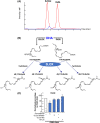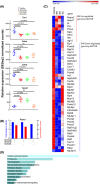Elucidating the structure and functions of Resolvin D6 isomers on nerve regeneration with a distinctive trigeminal transcriptome
- PMID: 34245621
- PMCID: PMC8362171
- DOI: 10.1096/fj.202100686R
Elucidating the structure and functions of Resolvin D6 isomers on nerve regeneration with a distinctive trigeminal transcriptome
Abstract
Innervation sustains cornea integrity. Pigment epithelium-derived factor (PEDF) plus docosahexaenoic acid (DHA) regenerated damaged nerves by stimulating the synthesis of a new stereoisomer of Resolvin D6 (RvD6si). Here, we resolved the structure of this lipid isolated from mouse tears after injured corneas were treated with PEDF + DHA. RvD6si synthesis was inhibited by fluvoxamine, a cytochrome P450 inhibitor, but not by 15- or 5-LOX inhibitors, suggesting that the 4- and 17-hydroxy of DHA have an RR- or SR-configuration. The two compounds were chemically synthesized. Using chiral phase HPLC, four peaks of RvD6si1-4 from tears were resolved. The RR-RvD6 standard eluted as a single peak with RvD61 while pure SR-RvD6 eluted with RvD63 . The addition of these pure mediators prompted a trigeminal ganglion transcriptome response in injured corneas and showed that RR-RvD6 was the more potent, increasing cornea sensitivity and nerve regeneration. RR-RvD6 stimulates Rictor and hepatocyte growth factor (hgf) genes specifically as upstream regulators and a gene network involved in axon growth and suppression of neuropathic pain, indicating a novel function of this lipid mediator to maintain cornea integrity and homeostasis after injury.
Keywords: Rictor; RvD6 stereoisomers; corneal nerves; hgf; pain; trigeminal ganglia transcriptome.
© 2021 The Authors. The FASEB Journal published by Wiley Periodicals LLC on behalf of Federation of American Societies for Experimental Biology.
Conflict of interest statement
The subject matter of this manuscript is protected by a US provisional patent application assigned to the Board of Supervisors of Louisiana State University and Agricultural and Mechanical College (LSU) and licensed to a company, CurVirBiotech, founded by co‐author Nicolas G. Bazan.
Figures





References
-
- Müller LJ, Marfurt CF, Kruse F, Tervo TMT. Corneal nerves: structure, contents and function. Exp Eye Res. 2003;76(5):521‐542. - PubMed
Publication types
MeSH terms
Substances
Grants and funding
LinkOut - more resources
Full Text Sources
Research Materials
Miscellaneous

